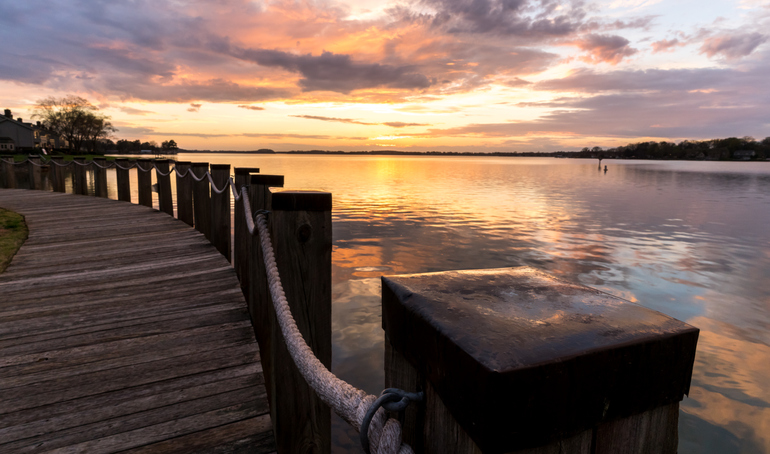How Nascar Turned This Lakefront Community Into One of America’s Hottest Luxury Housing Markets
The sport has become the driving force behind the Lake Norman area’s popularity, as big names like Dale Earnhardt Jr. and Denny Hamlin have built some of North Carolina’s most luxurious homes there
Luxury real-estate markets across the country are propelled by the biggest local industries, whether it’s high finance in New York, big oil in Texas, Walmart in Bentonville, Ark., or Hollywood in L.A. On North Carolina’s Lake Norman, there’s no disputing the driver: It’s Nascar.
The Lake Norman area, located roughly 20 miles north of Charlotte, N.C., has long been home to some of Nascar’s most successful drivers, thanks to its proximity to the Charlotte Motor Speedway and the headquarters of some of the sport’s best known teams. Over the past decade, some of the wealthiest drivers have plowed their winnings into building and buying some of the state’s most luxurious residences, helping to propel the local market to new heights.
Local agents say that, as a result, prices in the Lake Norman area are higher than they’ve ever seen. In Mooresville, N.C., roughly 10 miles east of the lake, racer Ricky Stenhouse Jr. is listing his 140-acre equestrian estate for $15.995 million, records show. In Cornelius, N.C., slightly farther south, a lakefront estate owned by telecommunications entrepreneur Robert Stevanovski and his wife, Sonya Stevanovski, is asking $16 million. If either traded for close to its asking price, it would set a record for the area, where prices have historically topped out around $8 million, agents said.
The median sale price for a home in Cornelius, N.C., has gone up by about 114%, to $476,000 from $222,000, since 2012, according to data from Realtor.com, while the median sale price for a home in Mooresville has gone up by about 118%, to $428,000 from $196,000. In comparison, the median sale price for a U.S. home rose by 91% between 2012 and 2022, to $342,000 from $179,000. Between January and August, the average median sale price was 21.8% higher in Cornelius and 28.1% higher in Mooresville compared with the average median sale price in 2021, outpacing the U.S. market’s 15.6% sale price growth for that period, the data show. (News Corp, owner of The Wall Street Journal, also operates Realtor.com under license from the National Association of Realtors.)
Agents attribute at least some of that upward momentum to the cash that’s poured into the market from Nascar over the past decade. Real-estate agent Reed Jackson of Ivester Jackson said that, on listings priced at $2 million or more, he’s likely to have interest from a buyer that’s somehow tied to the Nascar industry.
Among the most impressive Nascar-linked properties in the area is a roughly 300-acre estate outside of Mooresville owned by driver and Nascar Hall of Famer Dale Earnhardt Jr., who started assembling land in 2002 and has continued adding to it since. He lived in a modular home there until he replaced it with a new four-bedroom home, which was completed in 2008. It has a basement bar room with a theatre and pool table, he said. Mr. Earnhardt declined to offer details about the home’s size, or the cost of construction. He met his wife, Amy Earnhardt, when she was on the design team he hired for the project.
Mr. Earnhardt, 48, is a third-generation race-car driver. His late father, Dale Earnhardt Sr., was a seven-time Nascar champion. Mr. Earnhardt Jr. competed in the Nascar Cup Series from 1999 to 2017 and retired from the series with 26 cup wins including two Daytona 500 wins. Today, he spends his time running his racing team, JR Motorsports, which he’s owned since 2006. He is also an analyst for NBC Sports, hosts a podcast called “Dale Jr. Download” for his company, Dirty Mo Media, and just launched a vodka brand, High Rock, with Ms. Earnhardt.
Their estate has a string of unusual amenities, including an 800-square-foot treehouse with a loft that was built in 2015. The pièce de résistance: an elaborate life-size replica of an old western town in the backyard, complete with a saloon, a sheriff’s office with two jail cells, a bank with teller windows, and a church. Most of the buildings are just for show with a few props inside. Initially, Mr. Earnhardt used the town for partying with friends, but now that he and his wife have children, the space is mostly used for birthday parties, charitable events and sometimes music videos, he said. The inspiration came from watching the musician Willie Nelson on television giving a tour of a property he owned in Texas, which included an old western town movie set.
The property has some Nascar-inspired details, including about 70 acres of wooded, four-wheeler trails dotted with about 80 old race cars that have been ruined in accidents by his team and other teams across the industry.
“I call it the race-car graveyard,” Mr. Earnhardt said. “We go out there and ride the trails and there’ll be cars around every corner. You just never know what you’re going to see.”
Another of the area’s most valuable homes, according to local agents, is a roughly 30,000-square–foot lakefront estate on a peninsula in Cornelius built around 2016 for driver Denny Hamlin. The house is a sports fan’s paradise, with a full-length indoor basketball court, a putting green, a bowling alley, a golf simulator and a billiards area, as well as a large lounge with numerous TV screens, a spokesman for Mr. Hamlin confirmed. A Toyota race car that Mr. Hamlin drove to victory at the Daytona 500 in 2016 is on display inside a glass garage bay, complete with confetti still on the chassis from Victory Lane. There is also an area where Mr. Hamlin, who has won close to 50 Nascar Cup Series races as well as three Daytona 500s, displays his trophies and racing memorabilia. Local agents estimated that construction of the home could have cost between $15 million and $20 million. Mr. Hamlin declined to comment.
Driver Mr. Stenhouse’s home, the one on the market for $15.995 million, is evidence of Nascar’s continued influence on the area. Over the past two decades, it’s been owned by three prominent drivers, Ernie Irvan, Joe Nemechek and Mr. Stenhouse, who is now listing it for sale. The massive, 140-acre equestrian estate has a more than 9,000-square-foot home and an outdoor entertaining area with a lounge pavilion and an infinity pool.
The Nascar community began developing around the Charlotte area decades ago because it was central to many of the tracks that hosted races, according to Nascar Hall of Fame’s executive director, Winston Kelley. It was the birthplace of Holman-Moody in 1957, a major race-car manufacturing and restoration company and former race team, Mr. Kelley said. Even more eyes were drawn to the area in the 1960s, when the popular Charlotte Motor Speedway was completed in Concord, roughly 20 miles southeast of the lake. The track was among the largest at the time, Mr. Kelley said.
While many of the smaller, original tracks are no longer in business, the proximity of the Charlotte Motor Speedway still makes the area a racing hub. In Mooresville alone, which has been dubbed “Race City USA,” there are 54 motorsport manufacturers and teams with over 2,500 employees, according to the town’s mayor, Miles Atkins.
“All of the employees, drivers, mechanics, everybody really involved in the industry mostly lives in this area. It’s just become the hub,” Mr. Earnhardt said. “It’s just a coincidence that I was born and raised here but I suppose that if Nascar was located in another part of the country that’s where I’d be.”
Josh Tucker, an agent with Corcoran HM Properties in Mooresville, said there’s significant overlap in the Lake Norman area between Nascar and real-estate industries. He started his career as a mechanic for Nascar vehicles and eventually became what’s known as a “car chief,” making sure vehicles meet the criteria of Nascar inspections, before making the switch to real estate. He said he can’t remember a time when the area wasn’t a hub for Nascar greats.
“It seems like a lot of people I either represent on the buy side or the sell side end up having some connection down the line to Nascar,” he said.
Around Lake Norman, a flurry of recent big-ticket deals have been linked to the Nascar community in some way.
In June, a Cornelius estate that was owned by driver Joey Logano, two-time Nascar Cup Series champion who won at Daytona in 2015, sold for $4.3 million, a profit over the $3.6 million Mr. Logano paid in 2014, records show. The roughly 1-acre property sits directly on the lake and includes an Old World-style estate with cathedral arches, a beach, a dock, a billiards room and a four-car garage, according to the listing. Mr. Logano didn’t respond to requests for comment.
In September 2020, Rick Hendrick, the owner of the Nascar team Hendrick Motorsports, purchased a $6.3 million house on the lake in Denver, according to property and corporation records. The roughly 2.5-acre estate, located in a gated community, includes a four-car garage and a grand English manor-style home with a slate roof, glass lanterns and five bedrooms, the listing shows. It also has a pier with a helicopter pad.
It’s not just drivers and team owners driving prices up in the area. Agents say Nascar dollars spill over into other industries, like the news media that covers the sport, manufacturing, maintenance and marketing. “If you buy a lunchbox at Walmart with Jeff Gordon’s face on it, someone was involved in marketing that,” said local agent Ben Bowen, referencing one of the sport’s most well-known drivers.
Lake Norman has more to offer than just its Nascar associations, Mr. Tucker said, touting the area’s warm summers and mild winters, its big sprawling estates and the recreational possibilities of the lake. Lake Norman, created in the 1950s and 1960s as part of the construction of the Cowans Ford Dam, is one of the largest manmade lakes in the country and is a haven for boating, watersports and fishing. Alleged sightings of Normie, North Carolina’s equivalent of Scotland’s Loch Ness Monster, form local legend.
Much of the luxury real estate is on the east side of the lake, in the towns of Mooresville and Cornelius, which are more accessible to the airport and to the cities of Charlotte and Concord, where the Charlotte Motor Speedway, Nascar race shops, many of the Nascar teams, and the Nascar Hall of Fame are located.
On the west side of Lake Norman, in high-end communities like Denver, some of the wealthiest residents commute to Concord and Charlotte by helicopter, said Mr. Jackson, the agent.
The hottest areas are near two country clubs, the Peninsula Club in Cornelius and the Trump National Golf Club in Mooresville, agents said. While many buyers don’t want to live within the country club’s housing communities, the streets around them are considered the most desirable. Jetton Road, or what’s known locally as the “Jetton Peninsula,” which weaves past the Peninsula Club toward the Safe Harbor Peninsula Yacht Club, is home to some of the most elaborate properties. Similarly, in Mooresville, the “Brawley Peninsula,” Brawley School Road, goes past the Trump National Golf club out to the edge of the lake.
Starting in the late 1990s and through the mid- to late-2000s, the area played host to an arms race of new mansion development, Mr. Tucker said. That coincided with the peak of Nascar’s popularity and a wave of sponsorship dollars flowing into the sport. A large number of high-end homes were built on the edge of the lake, he said.
When it came to the drivers, many wanted significant garage space and lakefront docks.
“Just like they love fast cars, they also love fast boats,” said Mr. Tucker of his Nascar driver clients, noting that many drivers want their own docks with boat lifts.
Duke Energy, the company that operates the dam and a local power plant, regulates what can be built on the lake and requires a permitting process for new docks, however. A spokesman for the company said that, as development on the lake continues, it’s become more challenging to find property that’s appropriate for the construction of new deep-water docks.
“If a home already has a dock that’s grandfathered in, you likely wouldn’t be able to replicate that dock today,” Mr. Tucker said. “So a lot of buyers are looking for these older homes that have bigger docks that stick out further into the water.”
For some, restrictions around the lake are so tight that they would rather have a more rural property a little farther away from the water, Mr. Jackson said. “It’s not uncommon for them to buy more rural properties in farm areas around Lake Norman, and put up a separate automotive garage,” Mr. Jackson said.
The wave of new mansion development slowed down thanks in large part to the 2008 financial crisis, Mr. Tucker said, but saw an uptick again during Covid, as homebuyers looked for more space and greater access to amenities and the lake.
“When Covid hit, the McMansions became popular again,” he said. “People said, ‘Oh my gosh, we need more space, have a home theatre and home offices and fitness room and all these things.’ ”
The Covid crisis also brought many buyers to the area from Charlotte, a large number of whom worked in the financial-services industry at companies like Bank of America, which has its headquarters in North Carolina, said Mr. Tucker. He said this further drove up prices. In more recent months, Mr. Bowen said, agents have started to see more hesitation from buyers in the face of inflation, rising interest rates and recession fears.
Meanwhile, while Nascar has helped make the Lake Norman community what it is, some wonder if its influence will last forever. The declining popularity of the sport, as evidenced by lower viewership figures, means that some of the newer drivers aren’t making close to what the established drivers make. In the mid-2010s, the sport was a cultural phenomenon, inspiring the car-racing comedy movie “Talladega Nights: The Ballad of Ricky Bobby,” starring Will Ferrell. But only about 4.83 million people tuned into the Daytona 500 in 2021, compared with 16.65 million in 2013, a decrease of more than 70%, according to Sports Media Watch, a sports media publication.
According to Mr. Atkins, Mooresville’s mayor, one reason for the dip was because Nascar “got so big so fast,” and in the midst of corporate sponsorships, it lost touch with its base. But lately, he continued, there has been a renewed interest in driver personalities and rivalries, which were closely followed by the media when the organisation’s popularity hit its peak. When it comes to foot traffic, Mr. Kelley said that the Nascar Hall of Fame is bringing in more attendees now than before the pandemic, with attendance around 30% higher during the fiscal year of 2022 compared with 2019.
As for real estate, at least one agent said they don’t see the dip in viewership as an immediate threat to the real-estate market. “They’re still making enough money to buy very nice houses,” Mr. Tucker said.
 Copyright 2020, Dow Jones & Company, Inc. All Rights Reserved Worldwide. LEARN MORE
Copyright 2020, Dow Jones & Company, Inc. All Rights Reserved Worldwide. LEARN MORE
This stylish family home combines a classic palette and finishes with a flexible floorplan
Just 55 minutes from Sydney, make this your creative getaway located in the majestic Hawkesbury region.
As Paris makes its final preparations for the Olympic games, its residents are busy with their own—packing their suitcases, confirming their reservations, and getting out of town.
Worried about the hordes of crowds and overall chaos the Olympics could bring, Parisians are fleeing the city in droves and inundating resort cities around the country. Hotels and holiday rentals in some of France’s most popular vacation destinations—from the French Riviera in the south to the beaches of Normandy in the north—say they are expecting massive crowds this year in advance of the Olympics. The games will run from July 26-Aug. 1.
“It’s already a major holiday season for us, and beyond that, we have the Olympics,” says Stéphane Personeni, general manager of the Lily of the Valley hotel in Saint Tropez. “People began booking early this year.”
Personeni’s hotel typically has no issues filling its rooms each summer—by May of each year, the luxury hotel typically finds itself completely booked out for the months of July and August. But this year, the 53-room hotel began filling up for summer reservations in February.
“We told our regular guests that everything—hotels, apartments, villas—are going to be hard to find this summer,” Personeni says. His neighbours around Saint Tropez say they’re similarly booked up.
As of March, the online marketplace Gens de Confiance (“Trusted People”), saw a 50% increase in reservations from Parisians seeking vacation rentals outside the capital during the Olympics.
Already, August is a popular vacation time for the French. With a minimum of five weeks of vacation mandated by law, many decide to take the entire month off, renting out villas in beachside destinations for longer periods.
But beyond the typical August travel, the Olympics are having a real impact, says Bertille Marchal, a spokesperson for Gens de Confiance.
“We’ve seen nearly three times more reservations for the dates of the Olympics than the following two weeks,” Marchal says. “The increase is definitely linked to the Olympic Games.”

Getty Images
According to the site, the most sought-out vacation destinations are Morbihan and Loire-Atlantique, a seaside region in the northwest; le Var, a coastal area within the southeast of France along the Côte d’Azur; and the island of Corsica in the Mediterranean.
Meanwhile, the Olympics haven’t necessarily been a boon to foreign tourism in the country. Many tourists who might have otherwise come to France are avoiding it this year in favour of other European capitals. In Paris, demand for stays at high-end hotels has collapsed, with bookings down 50% in July compared to last year, according to UMIH Prestige, which represents hotels charging at least €800 ($865) a night for rooms.
Earlier this year, high-end restaurants and concierges said the Olympics might even be an opportunity to score a hard-get-seat at the city’s fine dining.
In the Occitanie region in southwest France, the overall number of reservations this summer hasn’t changed much from last year, says Vincent Gare, president of the regional tourism committee there.
“But looking further at the numbers, we do see an increase in the clientele coming from the Paris region,” Gare told Le Figaro, noting that the increase in reservations has fallen directly on the dates of the Olympic games.
Michel Barré, a retiree living in Paris’s Le Marais neighbourhood, is one of those opting for the beach rather than the opening ceremony. In January, he booked a stay in Normandy for two weeks.
“Even though it’s a major European capital, Paris is still a small city—it’s a massive effort to host all of these events,” Barré says. “The Olympics are going to be a mess.”
More than anything, he just wants some calm after an event-filled summer in Paris, which just before the Olympics experienced the drama of a snap election called by Macron.
“It’s been a hectic summer here,” he says.

AFP via Getty Images
Parisians—Barré included—feel that the city, by over-catering to its tourists, is driving out many residents.
Parts of the Seine—usually one of the most popular summertime hangout spots —have been closed off for weeks as the city installs bleachers and Olympics signage. In certain neighbourhoods, residents will need to scan a QR code with police to access their own apartments. And from the Olympics to Sept. 8, Paris is nearly doubling the price of transit tickets from €2.15 to €4 per ride.
The city’s clear willingness to capitalise on its tourists has motivated some residents to do the same. In March, the number of active Airbnb listings in Paris reached an all-time high as hosts rushed to list their apartments. Listings grew 40% from the same time last year, according to the company.
With their regular clients taking off, Parisian restaurants and merchants are complaining that business is down.
“Are there any Parisians left in Paris?” Alaine Fontaine, president of the restaurant industry association, told the radio station Franceinfo on Sunday. “For the last three weeks, there haven’t been any here.”
Still, for all the talk of those leaving, there are plenty who have decided to stick around.
Jay Swanson, an American expat and YouTuber, can’t imagine leaving during the Olympics—he secured his tickets to see ping pong and volleyball last year. He’s also less concerned about the crowds and road closures than others, having just put together a series of videos explaining how to navigate Paris during the games.
“It’s been 100 years since the Games came to Paris; when else will we get a chance to host the world like this?” Swanson says. “So many Parisians are leaving and tourism is down, so not only will it be quiet but the only people left will be here for a party.”
This stylish family home combines a classic palette and finishes with a flexible floorplan
Just 55 minutes from Sydney, make this your creative getaway located in the majestic Hawkesbury region.






















